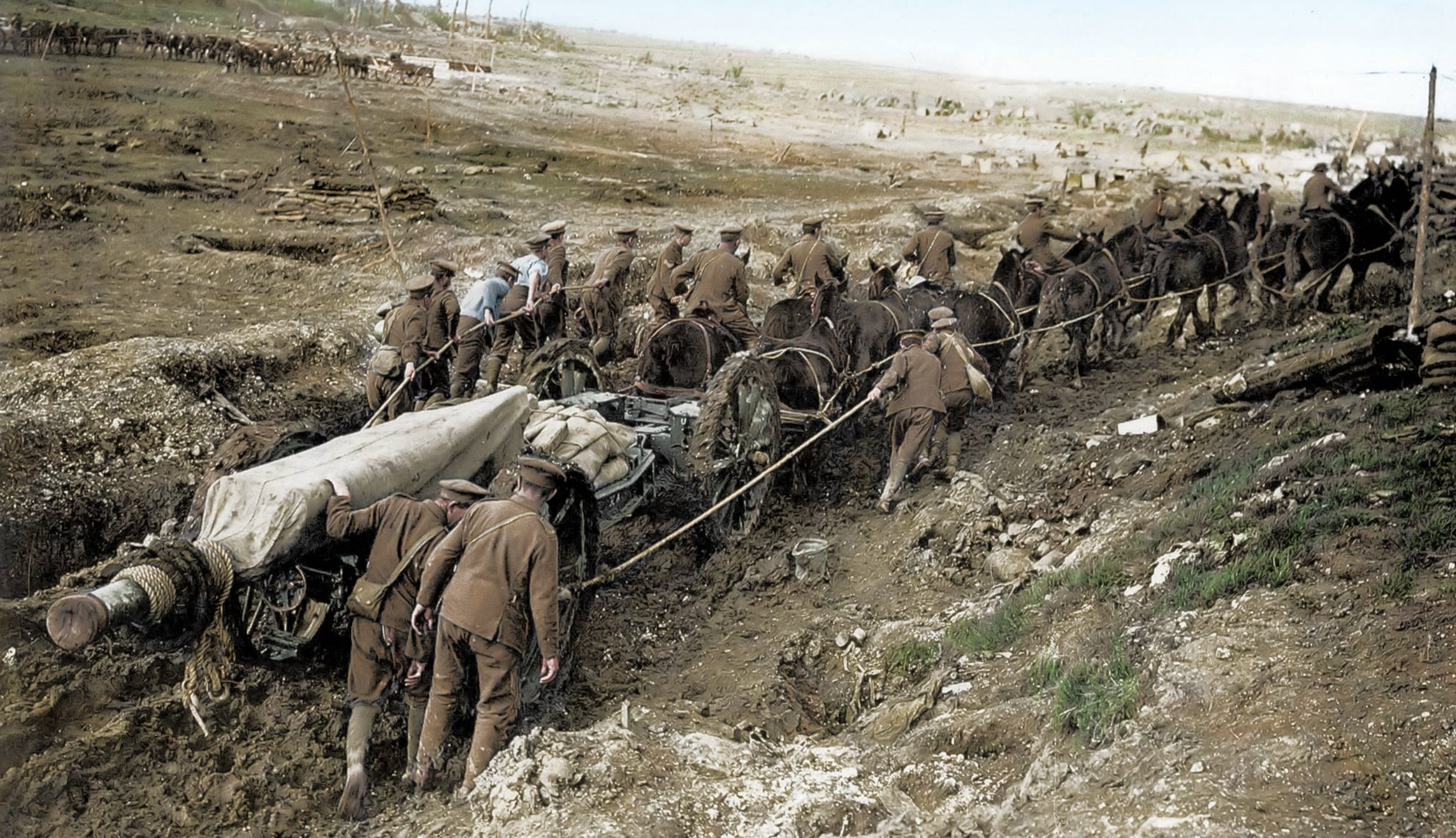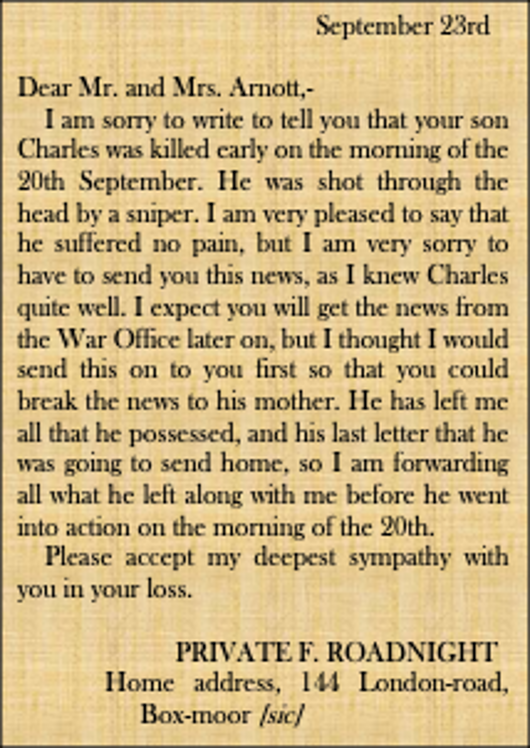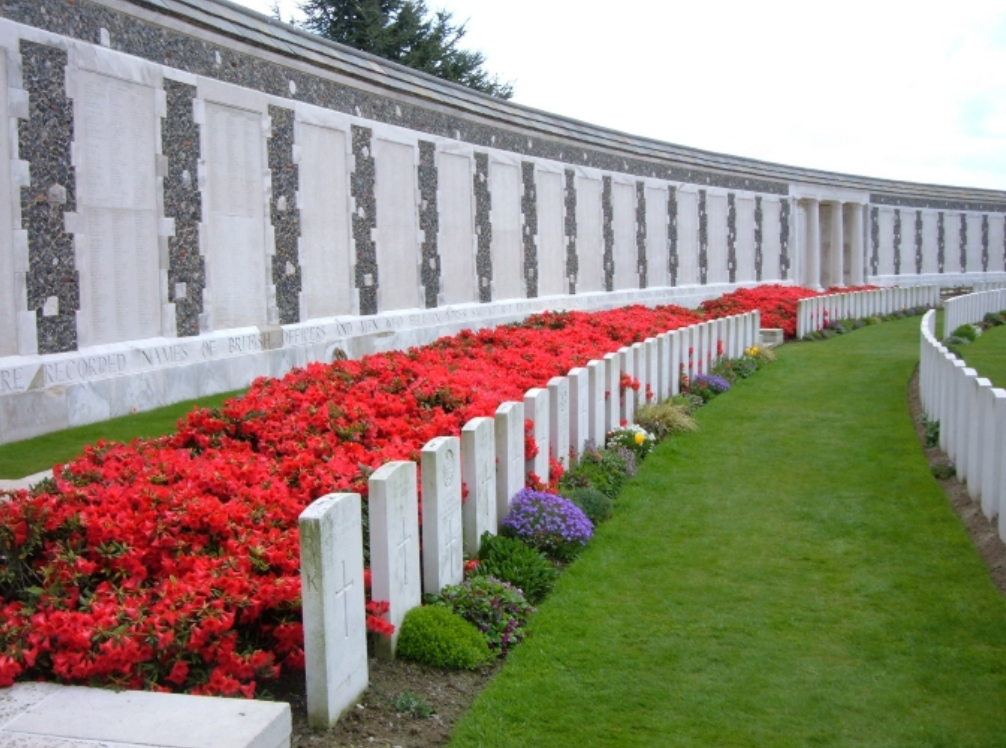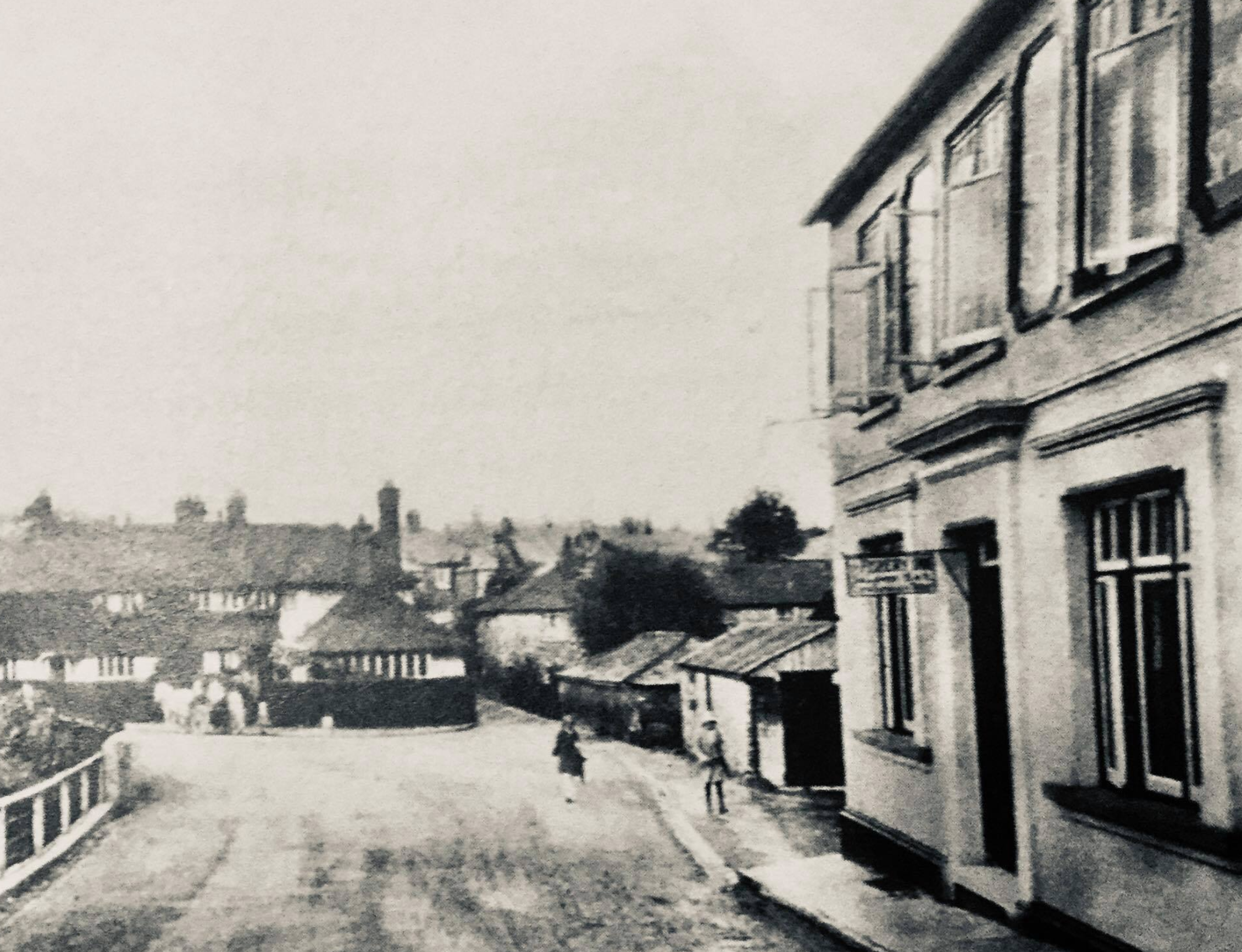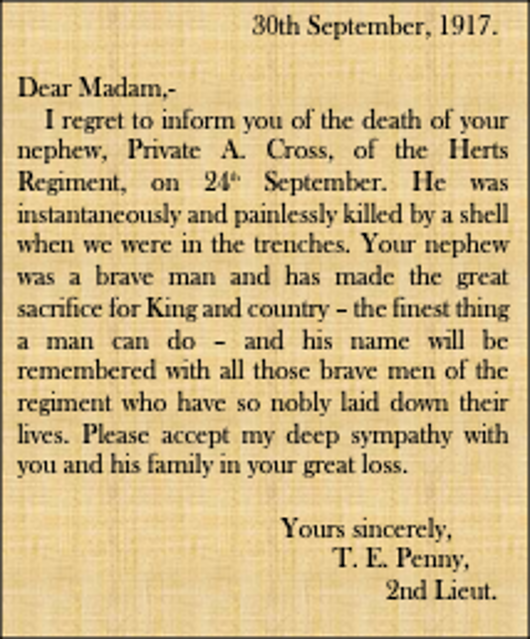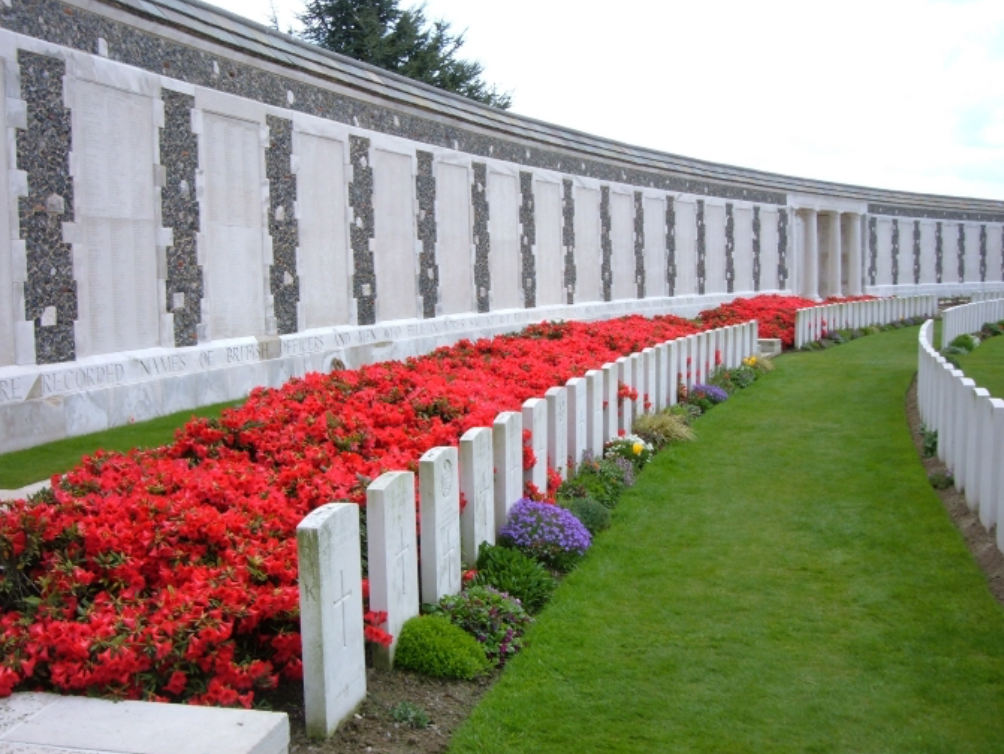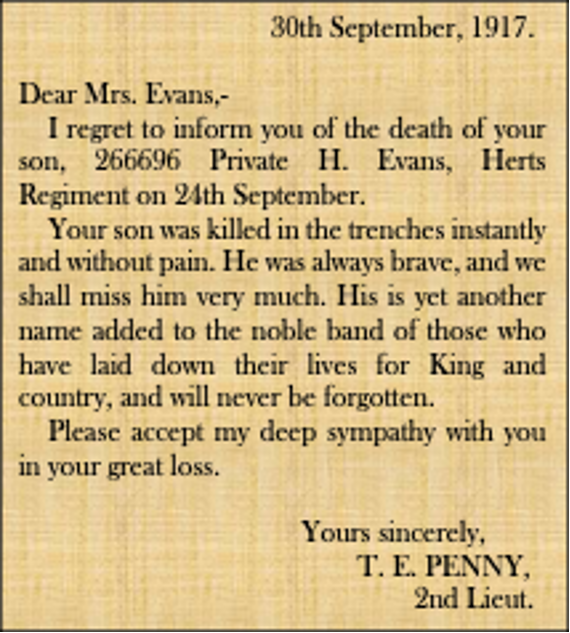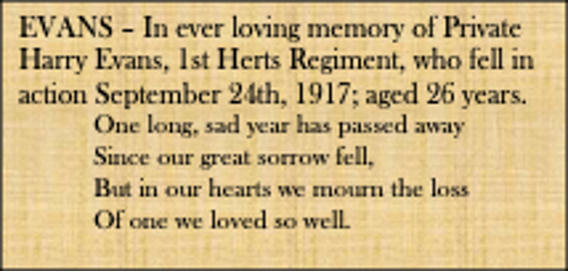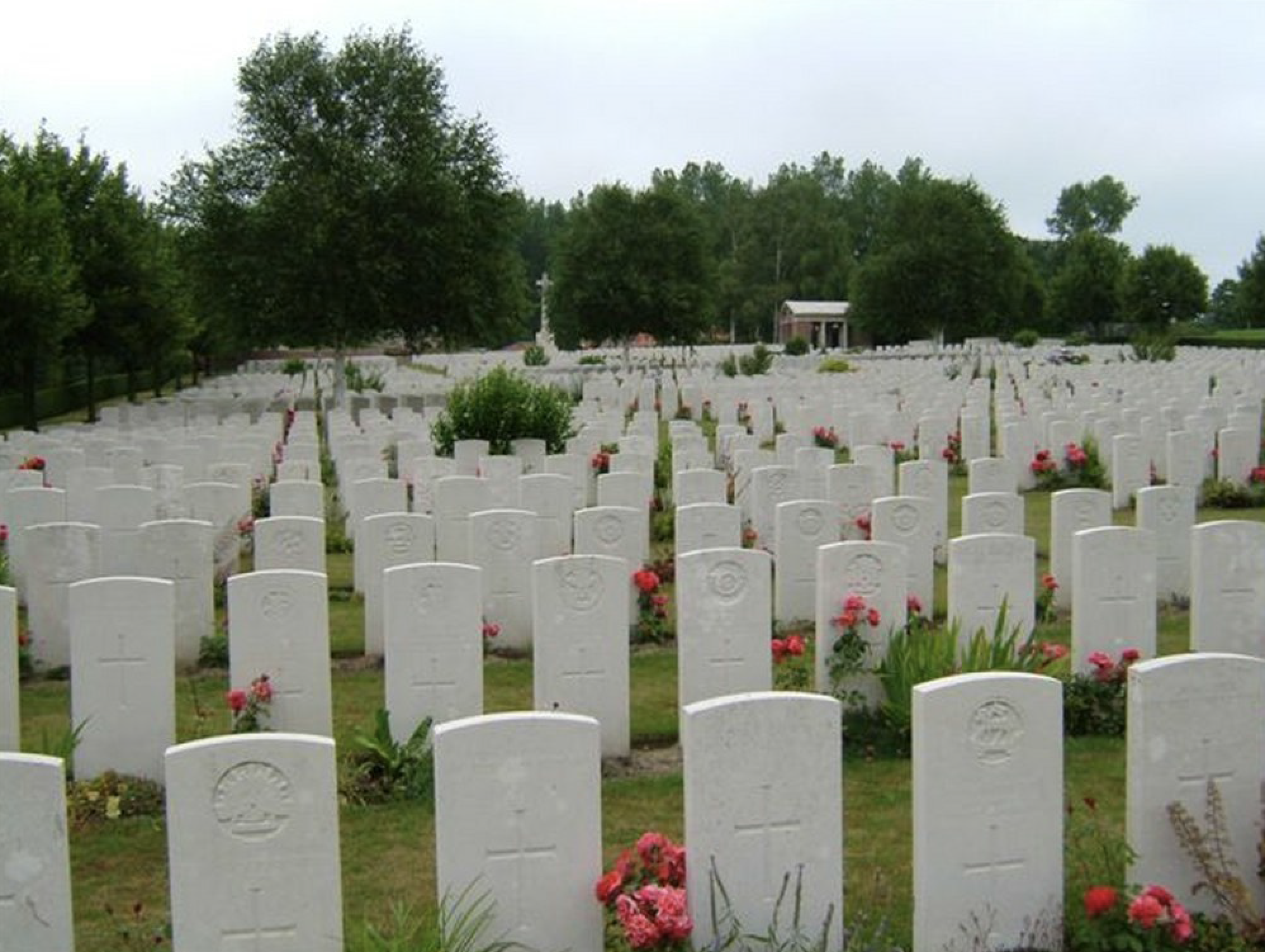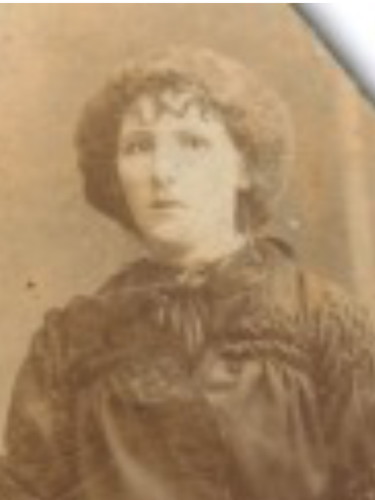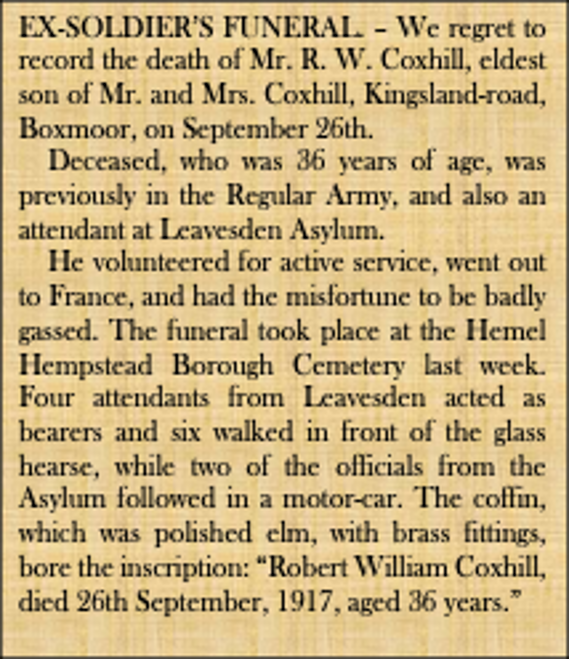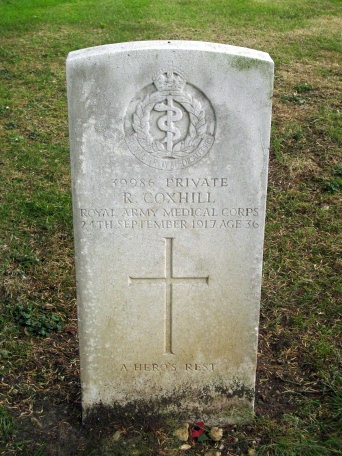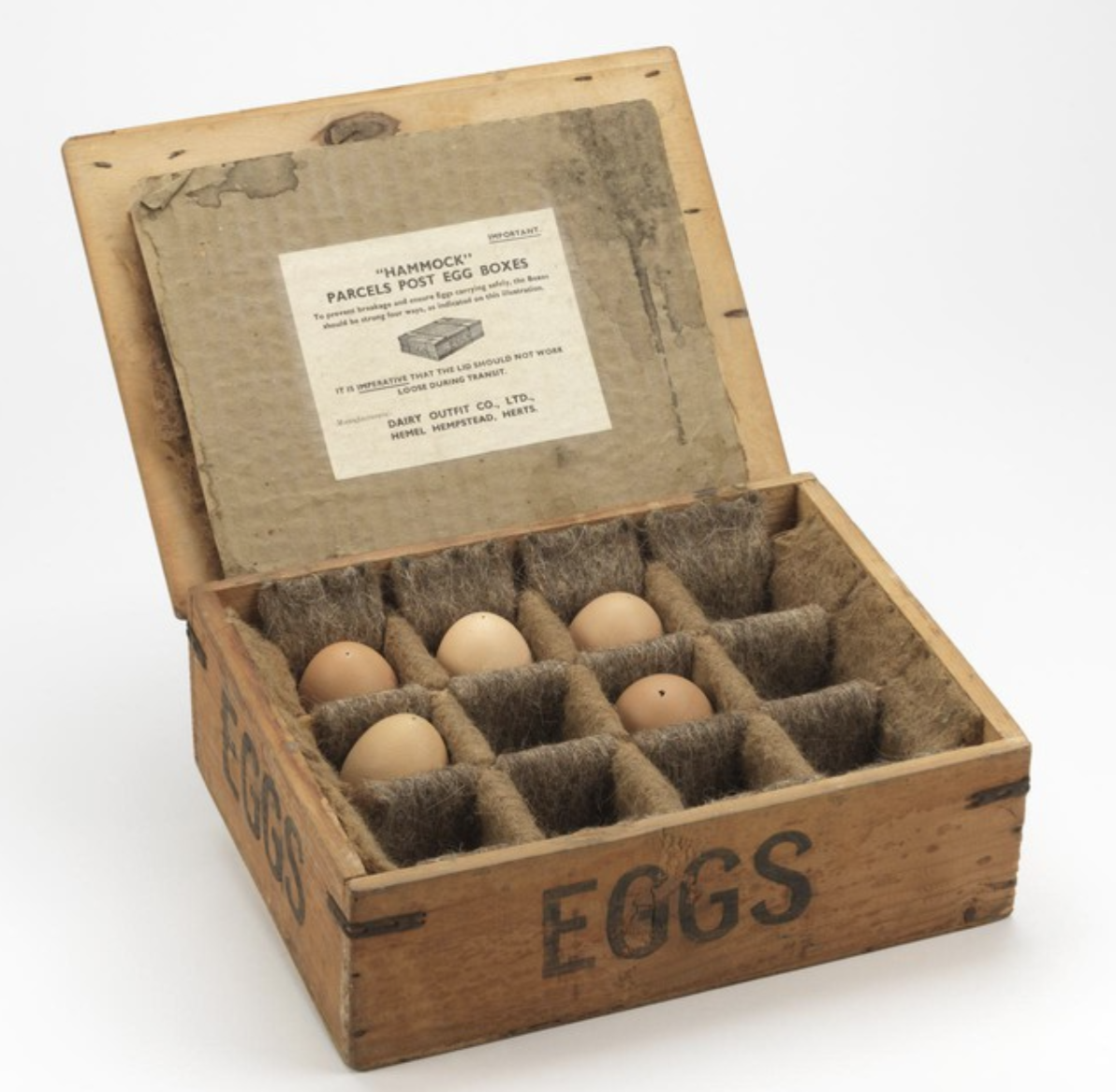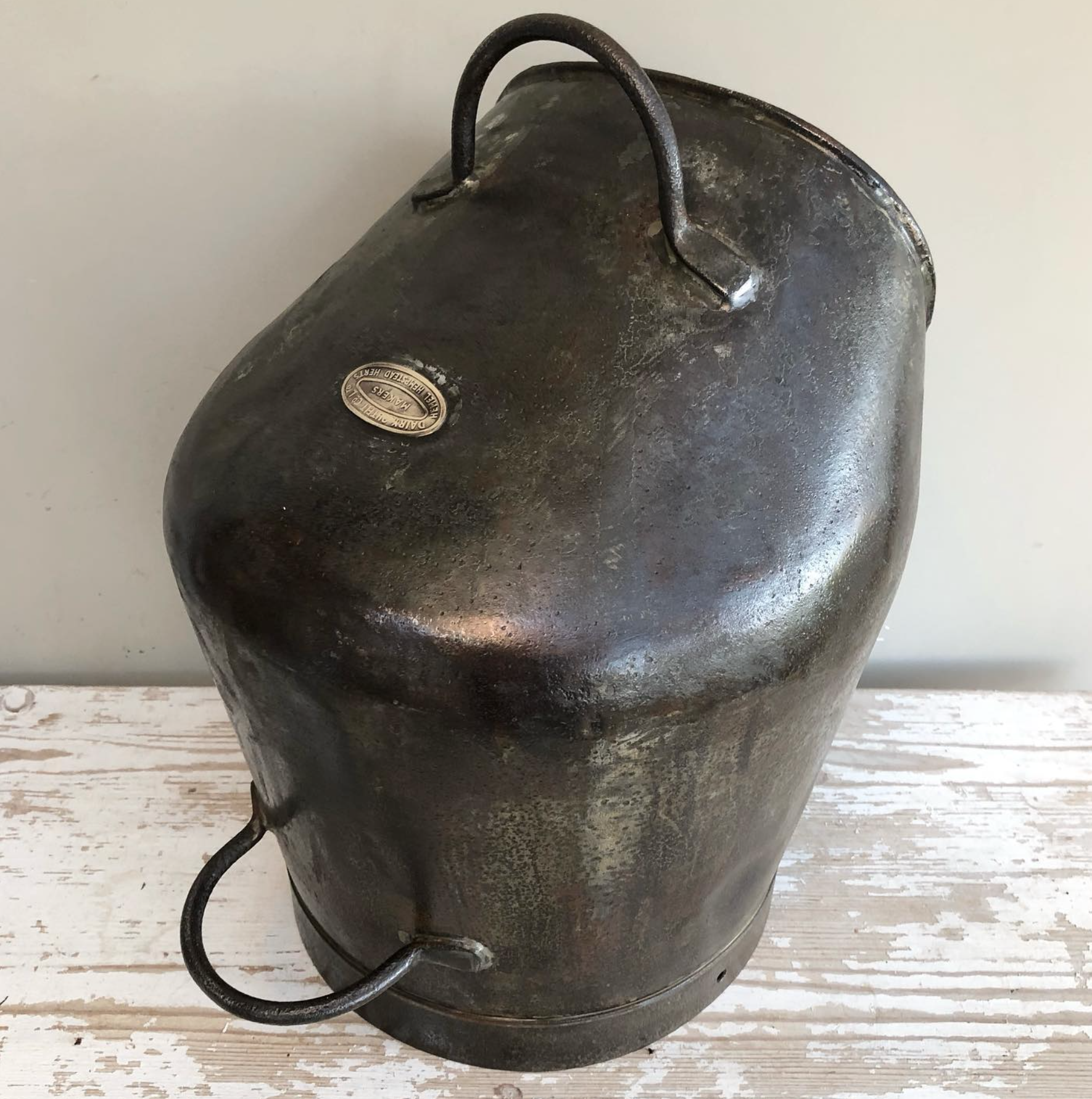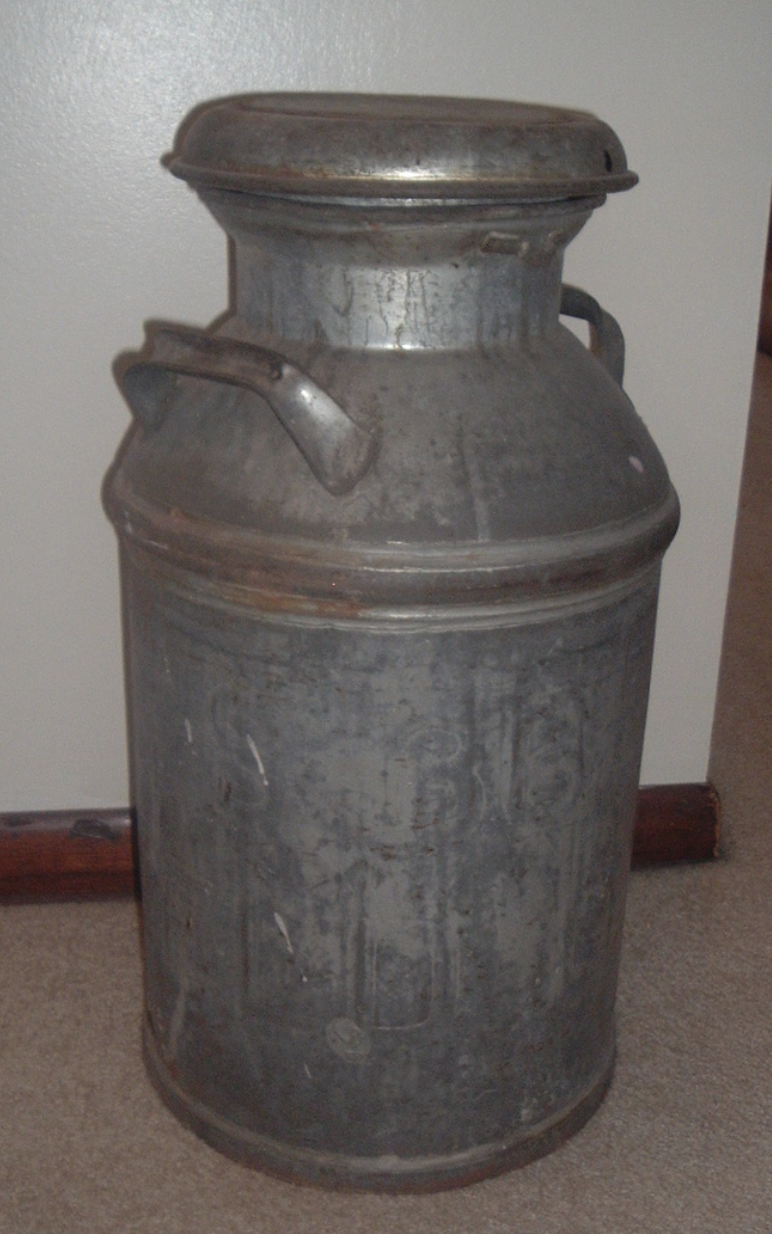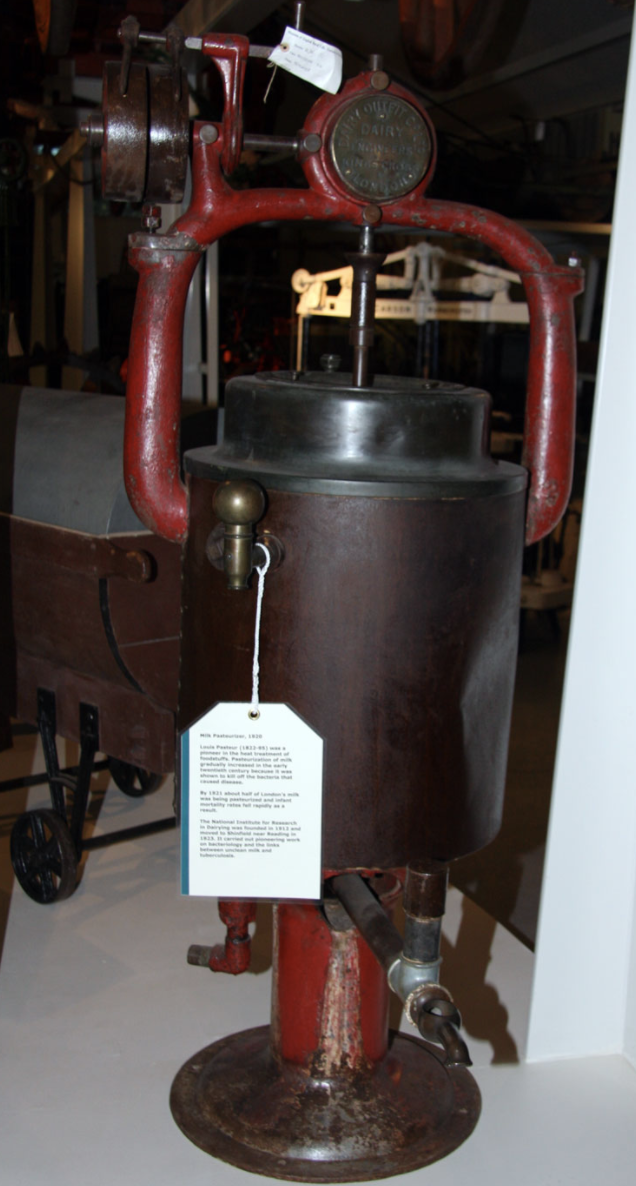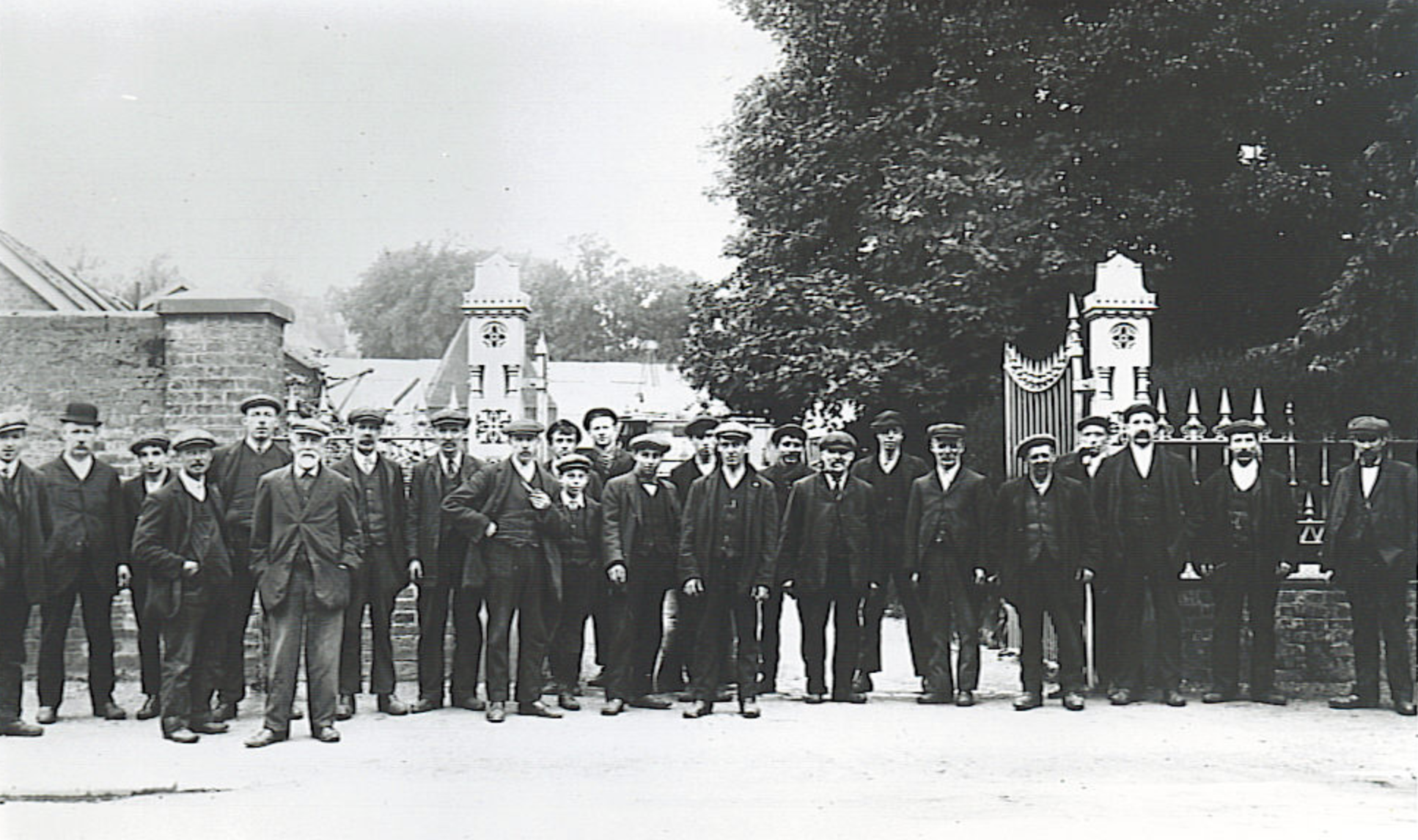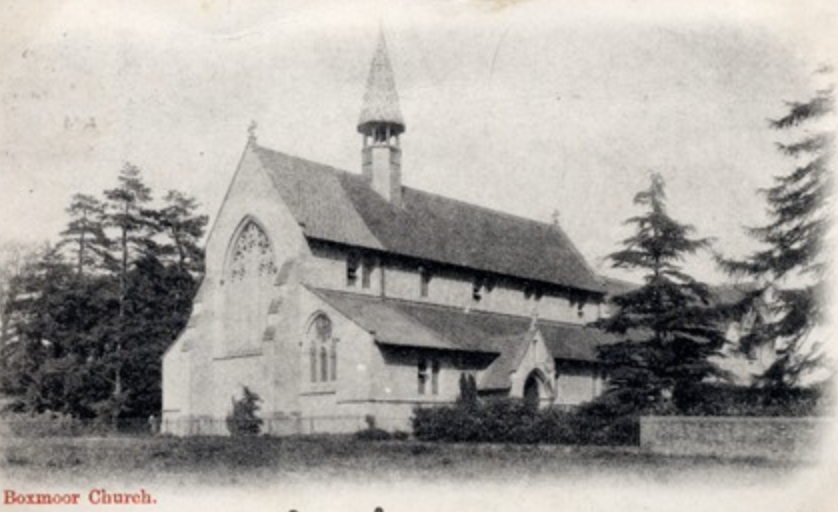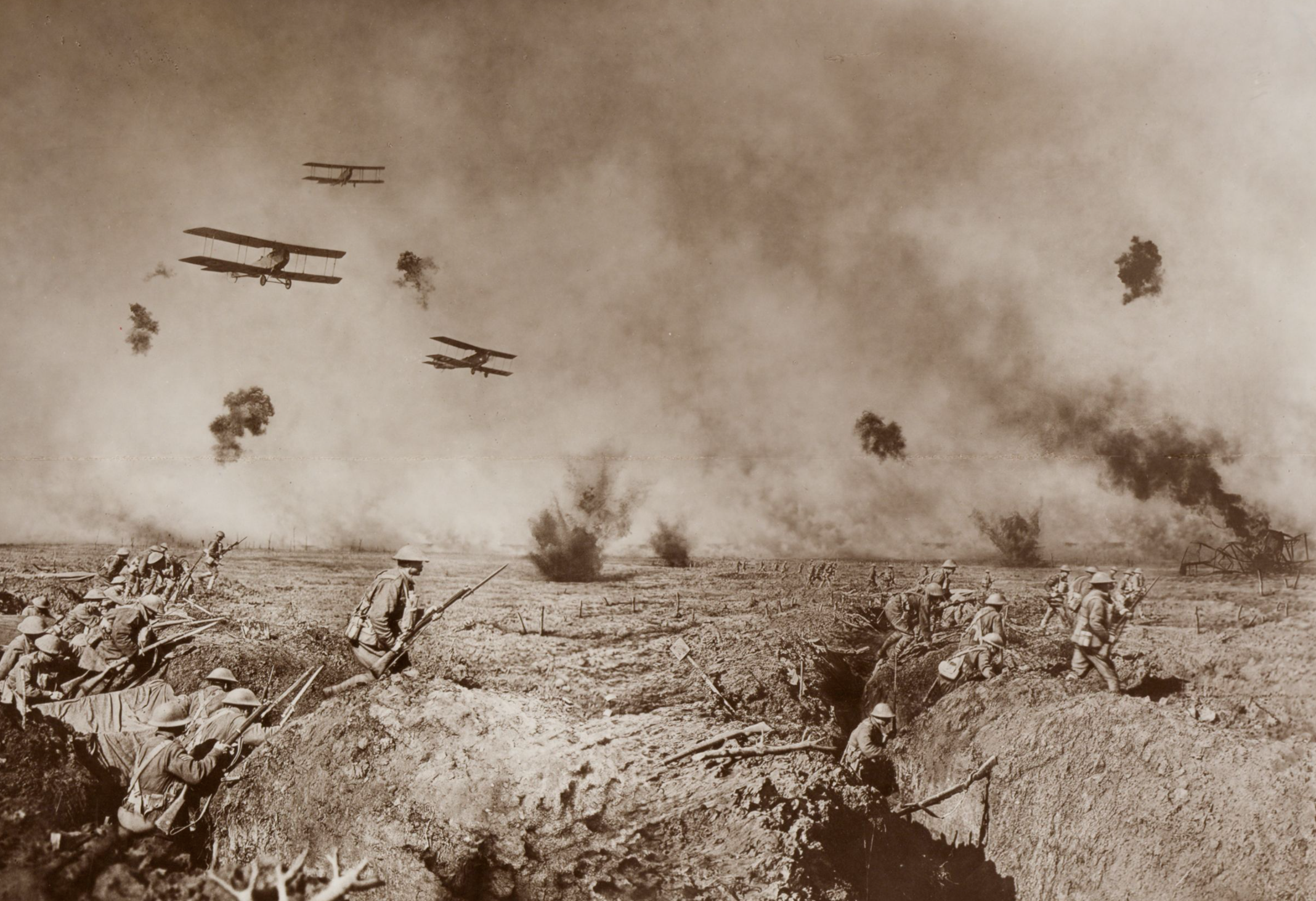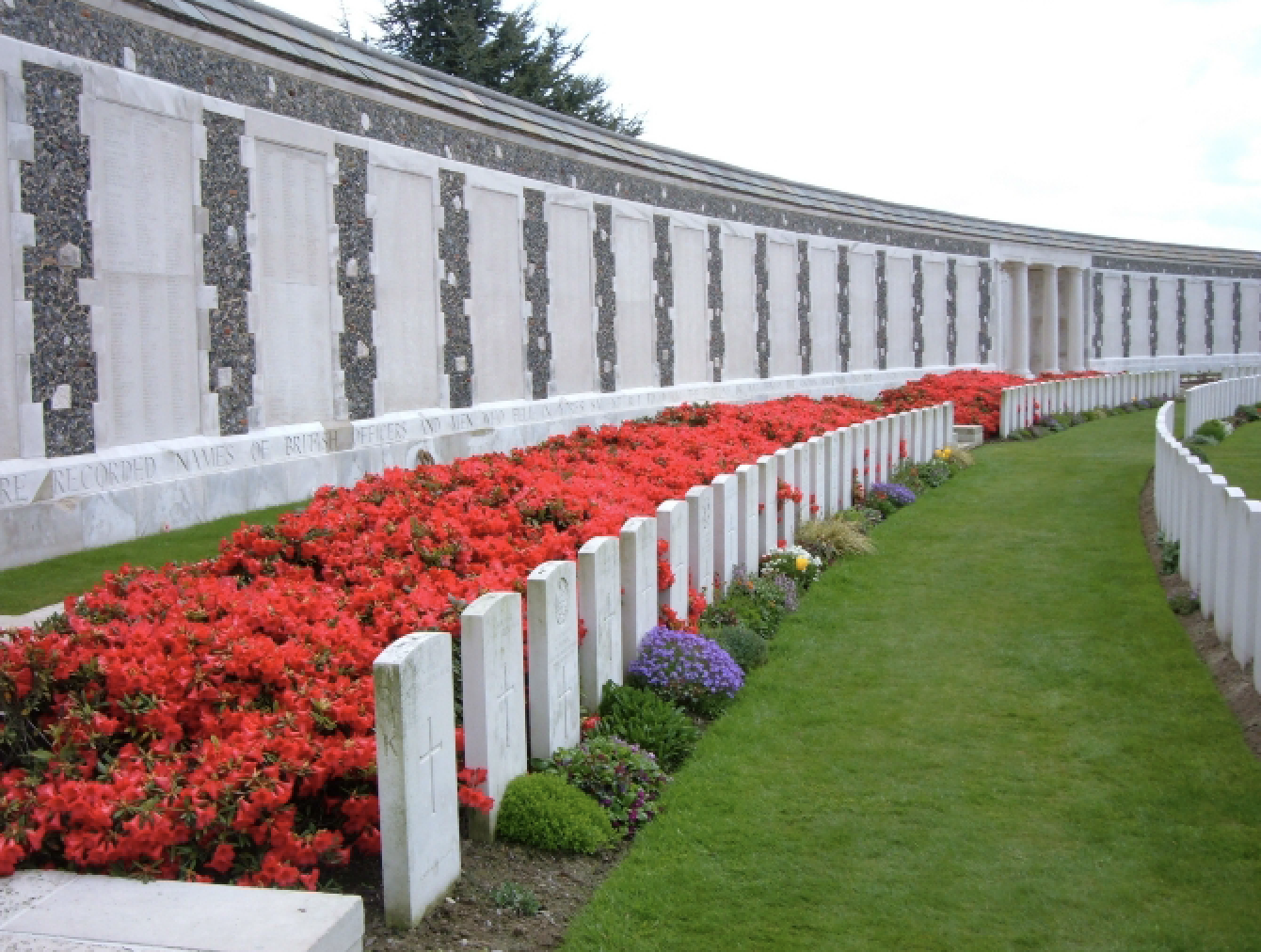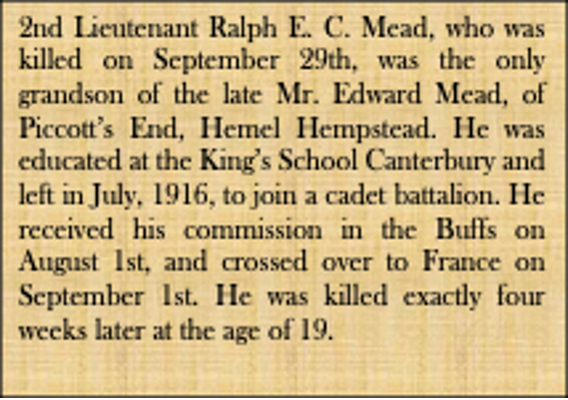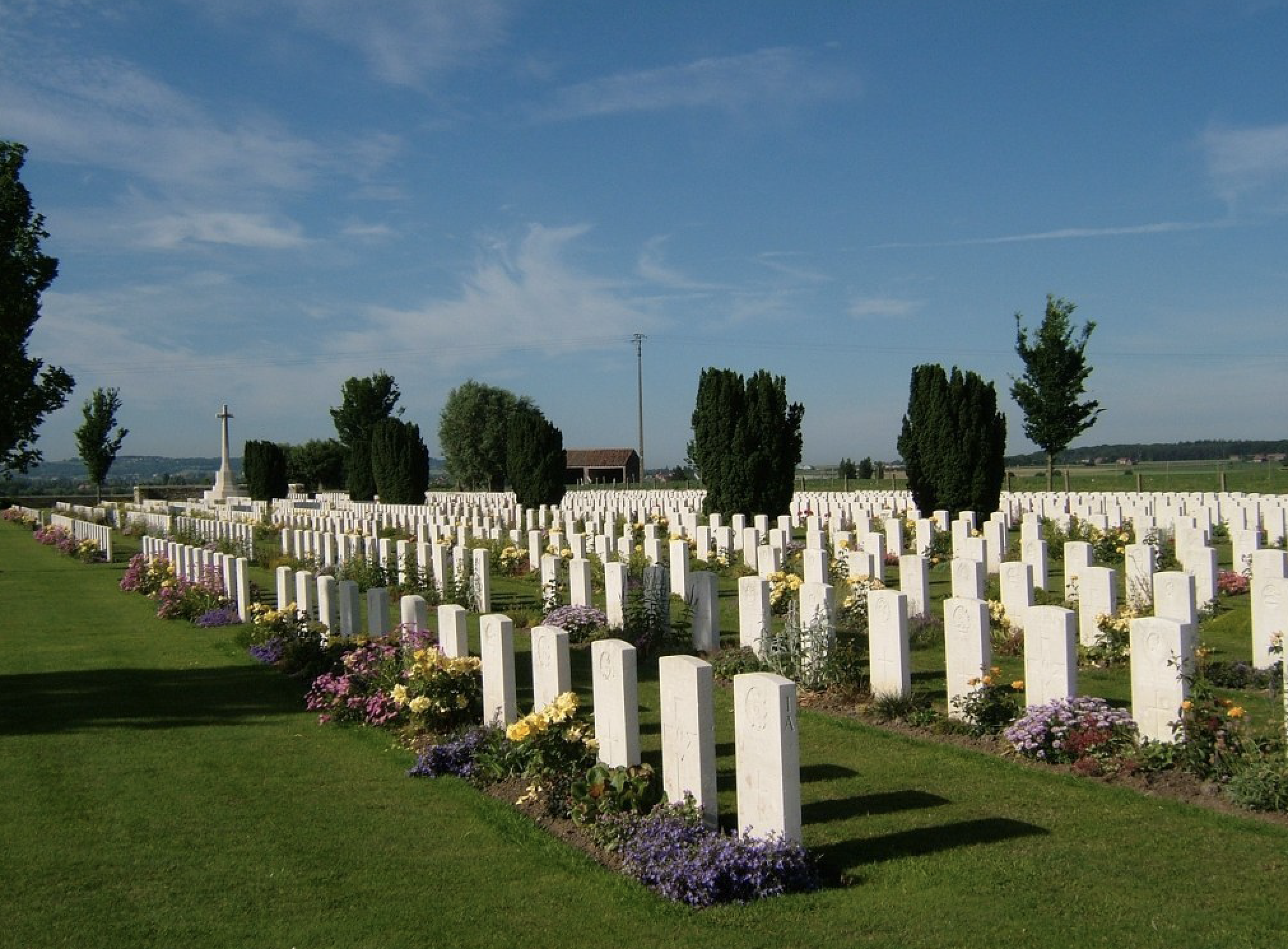Fallen in September 1917:
Charles Arnott
Arthur Amos Cross
Harry Evans
Robert William Coxhill
Robert William Gash
Ralph Edward Culverhouse Mead
CHARLES ARNOTT
18932 Private
2nd Bn., Bedfordshire Regiment
Killed in Action Thursday 20th September 1917
Remembered with Honour, Tyne Cot Memorial, West Vlaanderen, Belgium, Panel 48 to 50 and 162A.
Charles Arnott was born in Hemel Hempstead on Monday, 5th September 1892 and baptised the following month on Wednesday, 19th October in St Mary’s Church. He was the second child born to Charles Arnott and Annie Hitchcock who had a family of five together. The children were: James, Charles, Ethel May, Frank and the youngest Caroline.
When Charles was born, the family lived on Bury Hill in Hemel Hempstead and this is where he grew up. In fact, Charles’ father have lived on Bury Hill since he was born in 1870 and he remained there for sixty-four years, until his death in 1934. Charles senior worked for the Hemel Hempstead District Gas Company for many years, and in 1911 he was recorded on the Census return as a ‘Sulphur Maker’ at the Gasworks in Boxmoor. Sulphur was a by-product of gas production and often used to make sulphuric acid.
When Charles left school, he went to work for John Dickinson & Co. Limited in Apsley Mills where he was employed as an ‘Envelope Maker’. On the outbreak of war, he sought permission from his employer to enlist and in January 1915, he left Dickinsons and went to Bedford where he joined the Bedfordshire Regiment.
His basic training took place at Felixstowe and nine months later he was posted to the 2nd Battalion Bedfordshire Regiment and disembarked at Le Havre in France on the 2nd October 1915.
He joined his battalion two days later at Cuinchy billets in Le Quesnoy, along with 250 other new soldiers and by the end of the month he went into the trenches for the first time.
The rest of the year passed relatively quietly for Charles and the 2nd Battalion, but by late June 1916 he was at Maricourt on the Somme, as final preparations were made for the planned offensive.
On the 1st July 1916, the 2nd Bedfordshires were in support of the 17th and 20th Battalions King’s Liverpool Regiment which led the general advance. By the end of the day the objectives had been achieved and positions consolidated and for the next ten days Charles was involved in holding onto the hard won territory. On the 11th July the 2nd Bedfordshires attacked Trones Wood where it suffered heavy casualties in a day of hard fighting. There were over 240 men killed, wounded or missing, but Charles was fortunately not one of these.
He continued to fight through the next few months, until in October, the anniversary of his arrival in France, he took part in the Battle of Transloy where the casualties where again severe with 503 men lost. This included 125 men suffering from ‘Shell Shock’. The Battalion War Diaries record matter-of-factly along with the list of casualties, that “…a Draft of 10 Other Ranks joined from the Base.” A pitiful number when compared with the carnage over the previous two days. Once again however, Charles was a survivor.
By the end of the year the 2nd Bedfordshires had been reinforced and the War Diary records the closing entry for the year as follows: “STRENGTH OF BN. on 31st December, 1916 Offrs 34 W.O's 1 Sgts. 60 Cpls. 58 Ptes. 900 Total 1080 Total all ranks 1054.”
In April 1917, Charles fought in the Second Battle of the Scarpe, the opening encounter in the Battle of Arras and the last action he would experience in France. In May the Battalion moved to Belgium and took up positions in the Zillebeke sector and was in support at the Battle of Messines Ridge in June. The Battle of Pilckem Ridge followed at the end of July and still Charles’ good fortune held and he survived.
Throughout August he fought in the trenches until the 2nd Bedfordshires reached positions in Wytschaete on the 11th September. From then until the 19th September, the Bedfordshires were subject to gas attacks and incurred forty-seven casualties as a result.
On the 20th September orders were given for raids to be undertaken. The Battalion War Diaries record the details: “…a party consisting of 50 Other ranks, with orders to raid the Centre of Movement at O.12.c.25/70 for the purpose of collecting information, capturing Prisoners, Machine Guns and damaging Dug-outs. They were accompanied by a party of 8 R.E's with blasting charges. The party on nearing their objective were fired on heavily both with Machine Guns and Rifles. This fire, so intense, and the wire discovered to be uncut, made further advance and return impossible. The party, among whom were several wounded, remained in shell-holes during the whole day and returned about 9 p.m. to our own line. Much valuable information was collected from this enterprise…”
The Diary also recorded the casualties: “During the raid the following casualties occurred. 2/Lieut.T.G. Searle M.C. Wounded and Missing. Other Ranks: - Killed 8 Missing 4 Wounded & Missing 3 Wounded 13”.
Charles was in one of the raiding parties and he had been ‘picked off’ by a German sniper during the action. He was killed on Thursday, 20th September 1917.
Following his death, his family received a number of letters of sympathy from comrades and the regimental Chaplain and these were published in the Hemel Gazette. One of the letters came from Private Frederick William Roadnight who was serving with Charles. (see extract)
It is clear from the letter that Charles knew that there was a chance he could be killed during the planned raid. Indeed, these raids were extremely unpopular with soldiers because of the very high risks involved.
Pte. Charles Arnott c1915 (Photo: The Hertfordshire, Hemel Hempstead Gazette and West Herts Advertiser)
Sixty Pounder gun being moved into position at the Battle of Transloy (Photo: Royston Colour)
Extract from The Hertfordshire, Hemel Hempstead Gazette and West Herts Advertiser 13th Oct.1917
John Dickinson & Co. Limited War Memorial, Apsley (Photo:Traquair Photography)
Tyne Cot Memorial, West Vlaanderen, Belgium (Photo: CWGC)
Frederick Roadnight survived the War and returned to live out his life in Boxmoor.
Charles was commemorated on the John Dickinson & Co. Limited War Memorial in Apsley. (recorded incorrectly as ‘E. Arnott’)
Charles is Remembered with Honour on the Tyne Cot Memorial, West Vlaanderen, Belgium, Panel 48 to 50 and 162A.
He was 25 years old when he died.
Charles was entitled to the 1914-15 Star, the British War Medal and the Allied Victory Medal.
ARTHUR AMOS CROSS
266694 Private
1/1st Bn., Hertfordshire Regiment
Killed in Action Friday 21st September 1917
Remembered with Honour, Tyne Cot Memorial, West Vlaanderen, Belgium, Panel 153.
Arthur Amos Cross was born in Hemel Hempstead on Wednesday, 12th October 1881. His mother was Elizabeth Cross and he had two half-sisters: Minnie, who was five years older; and Lizzie (Elizabeth), who was three years younger. His mother Elizabeth died in 1895 when she was only thirty-nine years old and Arthur and his sisters were then raised by their Uncle and Aunt, Alfred and Ada Redding.
As children they lived next door to Alfred and Ada at 6 Fishery in Boxmoor, whilst at number 10 their Grandmother Emma lived with their Uncle Fred, Aunt Jane and their cousin Fred. Arthur’s mother Elizabeth kept house for Edward Gee in return for board and keep.
Arthur went to school at Boxmoor JMI where he successfully completed four of the seven Standards. In October 1893 he was absent from school due to a fever, but his teacher recorded a general attendance issue in Arthur’s class: “…over 20 boys are absent this afternoon ‘acorning’. St. IV do not attend well and are an awful drag”.
A year later the school log again records attendance issues relating to Arthur’s class-mates: “Oct 12th…29 boys were absent this afternoon the majority of them ‘blackberrying’”. It is not known if Arthur participated, but seven days after the ‘blackberrying’ incident he had reached the school leaving age and he went off to start work as a ‘Paper Boy’.
The following year he started working as a ‘Wood Sawyer’ with John Dickinson & Co. Limited in Apsley Mills. He continued to live with his Uncle and Aunt when they moved from Fishery, around the corner to 59 Horsecroft Road in Boxmoor. He lived there until he went to war.
Arthur enlisted in June 1915, attesting at Hemel Hempstead and joining the Hertfordshire Regiment. He was posted to Bury St. Edmunds for training and in early 1916, he was sent to France to join the 1/1st Battalion Hertfordshire Regiment. He arrived at the billets in Bethune on the 3rd or 7th January when 126 NCOs and men arrived as new drafts. By the middle of the month he was on the move as the Battalion marched to the support area at Givenchy.
It was mid-April near Festubert, before Arthur went into the trenches for the first time and it was not until October that he saw his first significant action when he fought in the Battle of Ancre Heights. One month later he fought in the last action of the Somme Offensive at the Battle of Ancre, which he came through unscathed although 147 of his comrades were not so fortunate.
The Battalion now moved to Belgium and took up position at Canal Bank near Ypres, in preparation for the next planned offensive. This came on the 31st July 1917 when the 1/1st Herts were heavily engaged in the Battle of Pilckem Ridge, the opening attack of the Third Battle of Ypres which will ever be remembered as the horror of ‘Passchendaele’.
The 1/1st Herts casualties at Pilckem were extremely heavy with some 459 men lost as the Battalion War Diary recorded: “Estimated casualties to the other ranks were 29 killed, 5 missing believed killed, 132 missing, 68 wounded & missing, 223 wounded & 2 died of wounds, making a total of 459 casualties to other ranks. Died of wounds; Officers 2, OR's 6. Missing; Officers 9, OR's 120. Wounded; Officers 8, OR's 180.” Arthur’s good fortune held however and he survived the carnage.
In August the Battalion were in support at the Battle of Langemarck shortly after which, on the 9th September, Arthur was awarded some very welcome home leave. He returned to Hemel Hempstead to see family and friends and take a well-deserved rest. Little did he realise that this would be the last time he would see home.
He returned to his Battalion on the 18th September, just in time to fight at the Battle of the Menin Road two days later. It was during this action, when Arthur was in the trenches, that his fortune finally gave out. A shell hit the trench and he was killed instantaneously.
Arthur died on Friday, 21st September 1917.
Following his death, a letter was received by his Aunt, now widowed, relating the circumstances of his demise. (see extract)
Records indicate three differing dates of death for Arthur: the above letter states the 24th September; the Army ‘Register of Effects’ states the 26th September; whilst the official War Office confirmation records the 21st September 1917. It is this last date that I have used in his biography.
Arthur was commemorated on the John Dickinson & Co. Limited War Memorial in Apsley.
Arthur is Remembered with Honour on the Tyne Cot Memorial, West Vlaanderen, Belgium, Panel 153.
He was 35 years old when he died.
Arthur was entitled to the British War Medal and the Allied Victory Medal.
Pte. Arthur Cross c1915 (Photo: The Hertfordshire, Hemel Hempstead Gazette and West Herts Advertiser)
"Fishery" in Boxmoor where Arthur lived as a child (Photo: Angela Jacobs)
Extract from The Hertfordshire, Hemel Hempstead Gazette and West Herts Advertiser 3rd Nov. 1917
John Dickinson & Co. Limited War Memorial, Apsley (Photo:Traquair Photography)
Tyne Cot Memorial, West Vlaanderen, Belgium (Photo: CWGC)
HARRY EVANS
266696 Private
1/1st Bn., Hertfordshire Regiment
Killed in Action Friday 21st September 1917
Remembered with Honour, Hooge Crater Cemetery, West Vlaanderen, Belgium, Grave XII. F. 6.
Harry Evans was born in the Spring of 1891 in Hemel Hempstead, the sixth of seven children born to Walter Evans and Harriet Buckthorp. Harry’s siblings were: Leonard Thomas, Horace William, Emily, Edith, Alice Ruth and Elsie.
His brother Leonard served with the Royal Fusiliers and was killed in 1918 and his biography also appears on this site. Their brother-in-law Horace Lavender, Alice’s husband, fought in and survived the conflict.
The Evans family lived at number 47 Chapel Street, Hemel Hempstead where all the children grew up. Harry’s father Walter worked as an ‘Iron Moulder’ for one of the two foundries in the town, Cranstone Engineering on the High Street or Boxmoor Ironworks on the Marlowes.
A year after he left school Harry joined John Dickinson & Co. Limited in 1905, where he worked as a ‘Clerk’ in Apsley Mills. During his time there he joined the Hertfordshire Territorials and served a four year term, leaving in 1913. On the outbreak of war he joined the local "Volunteers" and only left to join the Colours.
Harry re-enlisted with his old Regiment in June 1915 and immediately went to Bury St Edmunds to train for active service. On completion of his training he was sent to France where he was posted to the 1/1st Battalion Hertfordshire Regiment, which he joined at the beginning of January 1916.
In mid-April near Festubert, Harry went into the trenches for the first time, but it was October when he first experienced significant action in the Battle of Ancre Heights. One month later he fought in the last action of the Somme Offensive at the Battle of Ancre, which he came through unscathed although 147 of his comrades were casualties of that engagement.
The Battalion now moved to Belgium and on the 31st July 1917, Harry fought in the Battle of Pilckem Ridge, the opening attack of the Third Battle of Ypres which will ever be remembered as the horror of ‘Passchendaele’.
The 1/1st Herts casualties at Pilckem were extremely heavy with some 459 men lost as the Battalion War Diary recorded: “Estimated casualties to the other ranks were 29 killed, 5 missing believed killed, 132 missing, 68 wounded & missing, 223 wounded & 2 died of wounds, making a total of 459 casualties to other ranks. Died of wounds; Officers 2, OR's 6. Missing; Officers 9, OR's 120. Wounded; Officers 8, OR's 180.” Harry however survived the carnage.
In August the Battalion were in support at the Battle of Langemarck, allowing some recovery time from the terrible fighting at Pilckem, but on the 20th September it fought at the Battle of the Menin Road. It was during this action, when Harry was in the trenches, that he died as a shell hit the trench and killed him instantly. Another Hemel Hempstead soldier, Arthur Cross, was killed in this incident.
Harry died on Friday, 21st September 1917.
His mother received the following letter which was published in the Hemel Gazette. (see extract)
The article incorrectly states Harry’s date of death as the 24th September.
Harry was commemorated on the John Dickinson & Co. Limited War Memorial in Apsley.
A year after his death the following verse appeared in the Hemel Gazette. (see extract)
He was commemorated along with his brother Leonard on the St Paul’s Church memorial plaque. This was unfortunately lost when the church was demolished in the early 1960’s but, a replacement Memorial Scroll is on display in the new church at Highfield.
Harry is Remembered with Honour in the Hooge Crater Cemetery, West Vlaanderen, Belgium, where he is interred in Grave XII. F. 6.
He was 26 years old when he died.
Harry was entitled to the British War Medal and the Allied Victory Medal.
Pte. Harry Evans (Photo: The Hertfordshire, Hemel Hempstead Gazette and West Herts Advertiser)
Extract from The Hertfordshire, Hemel Hempstead Gazette and West Herts Advertiser 13th Oct. 1917
John Dickinson & Co. Limited War Memorial, Apsley (Photo:Traquair Photography)
Extract from The Hertfordshire, Hemel Hempstead Gazette and West Herts Advertiser 28th Sep. 1918
The Memorial Scroll, St. Paul's Church, Highfield, Hemel Hempstead (Photo: Traquair Photography)
Hooge Crater Cemetery, West Vlaanderen, Belgium (Photo: CWGC)
ROBERT WILLIAM COXHILL
39986 Private
Royal Army Medical Corps
Died of Wounds Monday 24th September 1917
Remembered with Honour, Hemel Hempstead (Heath Lane) Cemetery, United Kingdom, Grave AC. 54.
Robert William Coxhill, known as Bob, was born in Northchurch, Hertfordshire on Friday, 4th March 1881 and baptised in Berkhamsted on Sunday, 10th July in the same year. Robert was the second son and fourth child born to Charles Coxhill and Ruth Impey, who had sixteen children in total over a period of twenty-nine years. This impressive brood were: Mary Ellen (1875), John William Edward (1876), Sarah Jane (1878), Robert William (1881), Emma Jane (1883), George Edward (1885), Elizabeth Ethel (1887), Minnie (Mary) Elizabeth (1890), Jess (1892), James (1894), Lilly (1896), Annie and Jennie (1898), Willie (Charles William) (1901) and Dorothy Bessie (1904). Jess and Emma Jane died in 1894 aged two and one respectively, Jennie in 1898 days after birth, and John in 1911 aged thirty-five.
Bob’s brother George also fought in the Great War with the Royal Army Medical Corps (RAMC) and died as a result of his wounds in 1920. His biography appears on this site. James also served with the RAMC and survived the conflict.
The Coxhill family came to Boxmoor near Hemel Hempstead, from Berkhamsted in April 1891 and settled at 84 St John’s Road, from where ten-year-old Bob went to Boxmoor JMI school. The school admissions log recorded that Bob left Boxmoor to return to Berkhamsted in December 1891, although his family remained. It is possible he went back to his old school and stayed with a relative until he completed his education, finally leaving school in 1894.
Bob joined the army on his seventeenth birthday, 3rd March 1898, although he claimed to be eighteen which was the legal age for military service in the Regular Army. He had been working as a ‘Labourer’ at the time and was already a member of the Militia, having joined the 7th Battalion Royal Fusiliers. His experience there may have convinced him that a regular soldier’s life was more attractive than labouring, so he enlisted with the Royal Fusiliers.
During his four years on active service, his tours of duty took him to Malta, Gibraltar and finally Egypt, before he returned to England, where he transferred to the Army Reserve in February 1902. He remained in the Reserve for a further twelve years, before being discharged in April 1914.
Bob married Lizzie (Elizabeth) Barford on Saturday, 7th October 1905, in St John the Evangelist church in Boxmoor. Lizzie had been born in Luton, Bedfordshire and it appears that she and Bob met through her work. Her father was a ‘Straw Hat Maker’ and Lizzie worked as a ‘Finisher’ and made regular visits to the straw plait market in Hemel Hempstead to purchase raw materials.
By the time they married, Bob was working as an attendant at Leavesden Asylum where he would go on to train as a nurse. He and Lizzie soon had their own family and by the time Bob completed his first term in the Army in 1910, they lived with their first three children at 19 Asylum Cottages, Abbotts Langley. Their children were: Doris Evelyn born in 1905, Ivy Ruth in 1907, Gladys Irene in 1910, followed by Muriel Caroline in 1911 and finally their only son John Charles who arrived in 1913. Gladys died when she was only two-years-old in 1912.
As an experienced soldier and reservist, Bob was immediately called up for service on the outbreak of war. He attested at Watford in September 1914 and re-enlisted with the Army, this time with the Royal Army Medical Corps, where his skills as a ‘Male Nurse’ would be put to best use.
He was posted to 80th Field Ambulance and sent to France on the 18th September 1915, arriving at Le Havre three days later. Within a month of disembarking, Bob transferred to 4th Casualty Clearing Station (4th CCS) in the field and went to Beauval to the west of the Somme Valley.
Bob had been in France for just over three months when he showed early symptoms of Pulmonary Tuberculosis, which his Army Medical Records later described: “Originated Dec. 1915 at Beauvais [Beauval]. No previous history of chest trouble. No family history of tubercule. Cough commenced while on duty at Clearing Station. Right lung upper lobe and part of middle lobe involved. T.B. present in sputum. Result of active service, exposure and hardship. Permanent. Total incapacity.”
Bob was finally diagnosed with TB in his right lung and admitted to a Base Hospital on the 2nd April 1916 and shortly afterwards transferred back to England. He spent nineteen days from the 8th to the 26th April in a military hospital in Hampstead, London being treated for his condition. He was declared permanently unfit for military service on the 28th April. He was finally discharged from the Army on the 10th May 1916 and sent home to Abbotts Langley and his family.
Bob was unable to return to work and for the next year, he was examined regularly by the military authorities who reconfirmed his condition and incapacity. At this time there was no effective treatment or cure for tuberculosis and when the secondary form had taken hold, as in Bob’s case, often it was simply a matter of time.
This proved to be the outcome for Bob and he died on Monday, 24th September 1917 from his illness.
The Hemel Gazette published an account of his funeral. (see extract).
The piece incorrectly reported the date of his death and attributes the cause to the fact he was “…badly gassed…” during his service in France. There is no mention of this as a contributory cause of Bob’s illness in any of the military records, although that does not mean he did not suffer exposure to gas. Had this been the case, a weakening of his respiratory capacity may have made him more susceptible to the onset of T.B.
Bob and Lizzie Coxhill (Photo: Michael Sherfield)
Leavesden Asylum where Bob Coxhill worked (Photo: Hertfordshire Genealogy)
Extract from The Hertfordshire, Hemel Hempstead Gazette and West Herts Advertiser 6th Oct. 1917
Pte. Robert Coxhill Headstone, Hemel Hempstead (Heath Lane) Cemetery (Photo:Traquair Photography)
It could be that the information was simply mis-reported and confused with his brother George who had just been ‘gassed back’ to England, had also been in the RAMC, and was also a male nurse at Leavesden Asylum.
Whatever the confusion Bob Coxhill was a tragic victim of the Great War.
Bob is Remembered with Honour in the Hemel Hempstead (Heath Lane) Cemetery, United Kingdom, where he is interred in Grave AC. 54. The inscription on his headstone, requested by his father Charles, reads “A HERO’S REST”.
He was 36 years old when he died.
Bob was entitled to the 1914-15 Star, the British War Medal and the Allied Victory Medal.
ROBERT WILLIAM GASH
104177 Private
198th Coy., Machine Gun Corps (Infantry)
Killed in Action Wednesday 26th September 1917
Remembered with Honour, Tyne Cot Memorial, West Vlaanderen, Belgium, Panel 154 to 159 and 163.
Robert William Gash was born in Piccott’s End, Hemel Hempstead on Monday, 13th February 1893 and baptised at St Mary’s Church a month later on Sunday, 12th March. He was the only child of Robert George Gash and Alice Kempster. His mother Alice died aged twenty-eight, when Robert was just a year old in 1894. His father then remarried in 1896 to Lizzie Wise and Robert soon had a family of half siblings. These were: Alfred Cuthbert, Clara Katherine, Leonard Cecil, Mary Elizabeth and Dorothy Beatrice. His parents had two other children both of whom died in infancy.
Alfred served as a ‘signaller’ with the Berkshire Regiment and he too died in the Great War in 1918. His biography also appears on this site.
Robert started his education at Bury Mill End school in 1898 and at the end of the following year he was the subject of a little local controversy, when he transferred to Boxmoor JMI school. The Bury Mill End school log recorded the fact that Robert had transferred to Boxmoor when still only six-years-old in December 1899, much to the annoyance of his teacher: “Dec 1st: Robert Gash who will not be 7 years of age until February, has left this school and been admitted to Boxmoor Boys school. Mistress wrote to the Master pointing out that the child is ‘underage for admission to this school and that it is unfair that he should be removed just at the end of the school year when, as a matter of course, he would be transferred in February”.
The protest, however, was to no avail and young Robert had already started at Boxmoor by the time the Head Mistress wrote to her counterpart. Robert completed four of the seven ‘Standards’ and left in April 1906 to start his first job in ‘Domestic Service’ when he was thirteen-years-old.
By the time of the 1911 Census he had found employment as a ‘Fireman’ working for the 'Dairy Outfit Company', which was an engineering and manufacturing concern, making equipment for the dairy industry. This included wooden egg boxes, non-spill milking buckets, milk churns and pasteurisers. When he married in 1917, he was employed as a ‘Sheet Metal Maker’ at Boxmoor Iron Works on Marlowes.
Robert enlisted with the 1st Battalion Hertfordshire Regiment (TF) as a territorial soldier in January 1912 as a way to supplement his wages , but on the outbreak of war, it meant he was immediately mobilised for active service. Three months later on the 5th November he was sent to France where he disembarked at Le Havre on the following day.
Two weeks after arriving, he was in the trenches as the First Battle of Ypres neared its end. Following this the Battalion moved to France and took part in the actions around Cuinchy during the winter of 1915. Robert fought at the Battle of Festubert in May and then in the Battle of Loos in September.
On the 28th January 1916, Robert’s four year period of engagement with the 1st Herts terminated and he was discharged from the Army. However, he immediately re-enlisted and transferred to the Machine Gun Corps (MGC) and returned to England to train. He went back to France to fight at the Battle of the Somme in July with the 198th Company MGC and saw action throughout the Somme Offensive.
In January 1917 Robert was granted home leave and came back to Hemel Hempstead with one purpose in mind, to marry his sweetheart Alice Greenhill. Alice was a native of St Albans and when she and Robert met, she was working as an ‘Envelope Maker’ with John Dickinson & Co. Limited in Apsley Mills. They married in Hemel Hempstead on 13th March 1917 at St John the Evangelist Church in Boxmoor. Soon afterwards Robert returned to his unit in France never to see his wife again.
Alice did not remarry after Robert’s death and lived in Hemel Hempstead for many years before moving to Leighton Buzzard where she died in December 1979 aged eighty-five.
On his return to the Front, the 198th Company had moved to the 58th Division and Robert was soon back in action when he fought in the Battle of Bullecourt in May 1917. This was followed by two major engagements in September when he fought at the Battle of Menin Road Bridge and almost immediately afterwards at the Battle of Polygon Wood.
It was during this second engagement that Robert died when he was reported one of five men killed on Wednesday 26th September 1917.
He is commemorated on the War Memorial plaque in St. John the Evangelist Church in Boxmoor where he had worshipped and married.
Robert is Remembered with Honour on Tyne Cot Memorial, West Vlaanderen, Belgium, Panel 154 to 159 and 163.
He was 24 years old when he died.
Robert was entitled to the 1914-15 Star, the British War Medal and the Allied Victory Medal.
Products manufactured by the Dairy Outfit Company (Photos: IWM)
Workers at the entrance to Boxmoor Iron Works (Photo:https://www.ourdacorum.org.uk)
St. John the Evangelist Church, Boxmoor where Robert and Alice married (Photo: http://www.hertfordshire-genealogy.co.uk)
The Battle of Polygon Wood where Robert fell (Photo: State Library of New South Wales)
St. John the Evangelist Church War Memorial Plaque, Boxmoor (Photo: Traquair Photography)
Tyne Cot Memorial, West Vlaanderen, Belgium, (Photo: CWGC)
RALPH EDWARD CULVERHOUSE MEAD
2nd Lieutenant
7th Bn., The Buffs (East Kent Regiment)
Killed in Action Saturday 29th September 1917
Remembered with Honour, Nine Elms British Cemetery, West Vlaanderen, Belgium, Grave III. A. 2.
Ralph Edward Culverhouse Mead was born in Tunbridge Wells, Kent on Friday, 3rd June 1898 and baptised on Saturday, 2nd July of the same year. He was the second child and only son of Frank Mead and Grace Letitia Barbara Mackenzie and his older sister was Dorothy. Ralph’s mother Grace died on the 5th August 1900 at Oakfield Cottage, Dodd’s Lane in Piccott’s End when he was only two-years-old. Oakfield Cottage still stands on Dodd’s Lane today.
Ralph’s father Frank was a ‘Flour Miller’ in Chelsea and a third generation miller, following on from his Grandfather William and Father Edward who originally had milling interests in Tring.
Ralph’s Grandfather Edward had grown the business, acquiring premises in Wendover, Watford, Hunton Bridge and Chelsea. He is believed to have installed the country’s first roller mill at Chelsea and this is where Frank plied his trade. The success of the business meant that Ralph was born into a wealthy family and his father ensured that he had the best schooling he could afford.
Ralph first went to his local infants’ school in Glendower Place, Kensington, before moving to North Down Hill, a private boarding school in Margate and then briefly to Tonbridge School.
Finally, he went on to the King’s School Canterbury, the oldest continuously operating school in the world which was founded in 597 A.D. He was at King’s from January 1913 to July 1916 and whilst there he won a Junior Scholarship in November 1913 and a Senior Scholarship in June 1915.
Ralph was a member of the Officer Training Corps, becoming Quartermaster Sergeant and a keen cricketer and rugby player, winning ‘blues’ in both. In 1916, he was awarded an Open Classical Exhibition to Worcester College, Oxford, with a view to a medical career, but instead he enlisted with the Oxford University Officer Training Corps until he was old enough to enter a cadet battalion.
In early 1917 he was working at the Guards Camp at Pirbright with the Heavy Branch of the Machine Gun Corps with the stated aim of gaining command of a tank. Later that year, on the 27th June, he was commissioned as a 2nd Lieutenant in the 7th Battalion The Buffs (East Kent Regiment) and embarked for Belgium on 1st September.
It took until the end of the month for Ralph to arrive with his new Battalion which was at rest near Poperinghe training new drafts of men recently arrived from England. On the evening he arrived, a German aircraft dropped bombs into the camp, doing a great deal of damage. It was dark when the aeroplane came over at 7.20pm and dropped six bombs right into the camp which was very congested. This resulted in the death of twenty-seven men and the wounding of sixty-six others.
Ralph was one of the men killed and he died on Saturday, 29th September 1917. He had been in Flanders for exactly four weeks and with his Battalion for less than a day when he was killed.
His death was reported in the Hemel Hempstead Gazette in October. (see extract)
He is commemorated on the Roll of Honour at King’s School Canterbury, the memorial at Tonbridge School and also at Worcester College, Oxford.
Ralph is Remembered with Honour in Nine Elms British Cemetery, West Vlaanderen, Belgium, where he is interred in Grave III. A. 2.
The inscription on his headstone, requested by his father Frank reads: “ONLY SON OF FRANK AND GRACE MEAD OF CHELSEA FAITHFUL UNTO DEATH”
He was only 19 years old when he died.
Ralph was entitled to the British War Medal and the Allied Victory Medal.
2nd Lieutenant Ralph Culverhouse (Photo: John Hamblin www.hambo.org/kingscanterbury)
Chelsea Flour Mills (Photo: The Library Time Machine)
Extract from The Hertfordshire, Hemel Hempstead Gazette and West Herts Advertiser 20th Oct. 1917
Nine Elms British Cemetery, West Vlaanderen, Belgium, (Photo: CWGC)
2nd Lieut. Ralph Mead’s Headstone (Photo: Traquair Photography)
